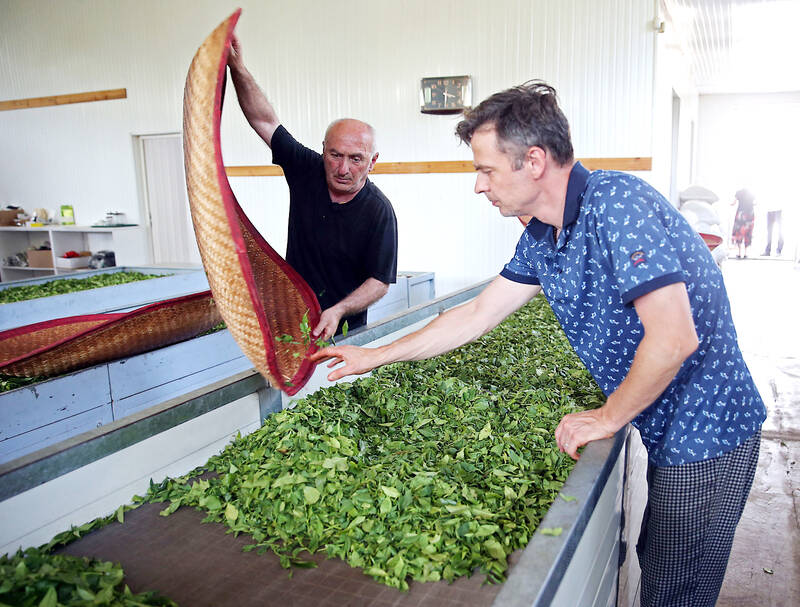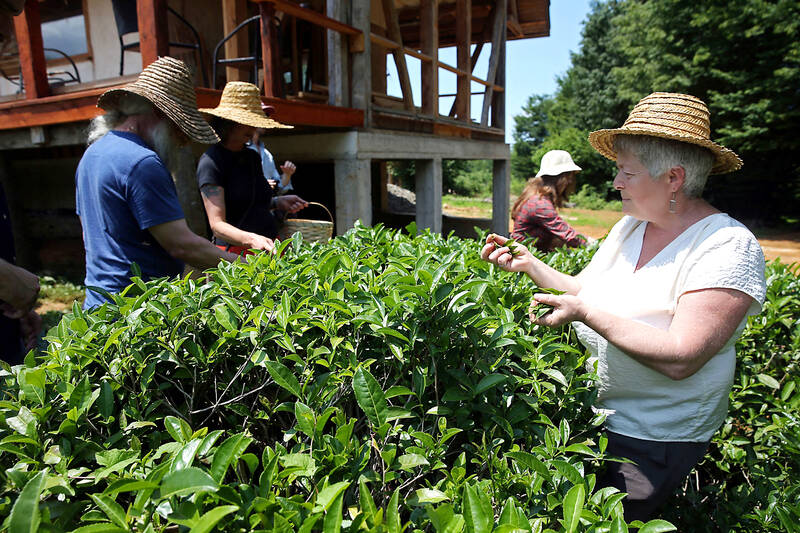When Lika Megreladze was a child, life in her native western Georgian region of Guria revolved around tea.
Her mother worked for decades as a scientist at the Soviet Union’s Institute of Tea and Subtropical Crops in the village of Anaseuli, Georgia, perfecting cultivation methods for a Georgian tea industry that supplied the bulk of the vast communist state’s brews.
“When I was a child, this was only my mum’s workplace. Only later I realized that it was something big,” she said.

Photo: Reuters
Now, the institute lies abandoned. Yellowed papers are strewn around its decaying corridors, and a statue of Soviet founder Vladimir Lenin lies toppled and overgrown in the courtyard.
Throughout Guria’s verdant subtropical hills, sprawling plantations have relapsed into jungly thickets interspersed with wild forests of tea. Dozens of cavernous old tea factories stand empty and deserted.
Introduced to Georgia in the early 20th century by a Chinese expert invited by the Imperial Russian authorities, tea plants flourished in the hot, humid climate of Guria, which stretches down from the Caucasus mountains to the Black Sea coast.

Photo: Reuters
However, for the tea industry, the restoration of Georgia’s independence in 1991 after two centuries of rule from Moscow came almost as a death blow.
The collapse of the Soviet Union opened its market to cheaper Asian imports, while the disintegration of the Georgian economy amid a brief civil war in the early 1990s saw electricity cut off, and tea factories plundered for spare parts and scrap metal.
By 2016, according to official figures, Georgian tea production had declined 99 percent from its 1985 peak.
“The institute collapsed because the Soviet Union collapsed,” said Megreladze, who now owns a guesthouse and cultivates her own small tea plantation for visitors.
“Georgia, a young country, could not save this huge industry,” she said.
Now, more than three decades since the Soviet collapse, some locals are trying to revive the tea industry. Ten years ago, Nika Sioridze and Baaka Babunashvili began rehabilitating derelict tea plantations, financed partly by a grant from the Georgian government.
Their GreenGold Tea is one of several new companies that brought tea fields in and around Ozurgeti, Guria’s regional capital, back to life.
Processing their tea in one wing of an abandoned Soviet silk factory in the town, they aim to reintroduce Georgian tea to local and European buyers.
“For 40 years nothing was happening here. Here was a jungle,” founder Sioridze said.
Under the Soviet Union, which prioritized quantity of production above all, Georgian tea mainly acquired a poor reputation for quality. Guria’s fields grew mostly simple black teas, with bushes harvested by machines, seeing older leaves and even stems thrown into the mix.
Now, they say, their task is to reinvent Georgian tea as a high quality, distinctive product for a new era.
“We must be different from Chinese tea makers, Taiwanese tea makers,” Sioridze said. “Because Georgia is Georgia and we need some niche to make our own tea.”

JITTERS: Nexperia has a 20 percent market share for chips powering simpler features such as window controls, and changing supply chains could take years European carmakers are looking into ways to scratch components made with parts from China, spooked by deepening geopolitical spats playing out through chipmaker Nexperia BV and Beijing’s export controls on rare earths. To protect operations from trade ructions, several automakers are pushing major suppliers to find permanent alternatives to Chinese semiconductors, people familiar with the matter said. The industry is considering broader changes to its supply chain to adapt to shifting geopolitics, Europe’s main suppliers lobby CLEPA head Matthias Zink said. “We had some indications already — questions like: ‘How can you supply me without this dependency on China?’” Zink, who also

The number of Taiwanese working in the US rose to a record high of 137,000 last year, driven largely by Taiwan Semiconductor Manufacturing Co’s (TSMC, 台積電) rapid overseas expansion, according to government data released yesterday. A total of 666,000 Taiwanese nationals were employed abroad last year, an increase of 45,000 from 2023 and the highest level since the COVID-19 pandemic, data from the Directorate-General of Budget, Accounting and Statistics (DGBAS) showed. Overseas employment had steadily increased between 2009 and 2019, peaking at 739,000, before plunging to 319,000 in 2021 amid US-China trade tensions, global supply chain shifts, reshoring by Taiwanese companies and

Taiwan Semiconductor Manufacturing Co (TSMC, 台積電) received about NT$147 billion (US$4.71 billion) in subsidies from the US, Japanese, German and Chinese governments over the past two years for its global expansion. Financial data compiled by the world’s largest contract chipmaker showed the company secured NT$4.77 billion in subsidies from the governments in the third quarter, bringing the total for the first three quarters of the year to about NT$71.9 billion. Along with the NT$75.16 billion in financial aid TSMC received last year, the chipmaker obtained NT$147 billion in subsidies in almost two years, the data showed. The subsidies received by its subsidiaries —

OUTLOOK: Pat Gelsinger said he did not expect the heavy AI infrastructure investments by the major cloud service providers to cause an AI bubble to burst soon Building a resilient energy supply chain is crucial for Taiwan to develop artificial intelligence (AI) technology and grow its economy, former Intel Corp chief executive officer Pat Gelsinger said yesterday. Gelsinger, now a general partner at the US venture capital firm Playground Global LLC, was asked at a news conference in Taipei about his views on Taiwan’s hardware development and growing concern over an AI bubble. “Today, the greatest issue in Taiwan isn’t even in the software or in architecture. It is energy,” Gelsinger said. “You are not in the position to have a resilient energy supply chain, and that,